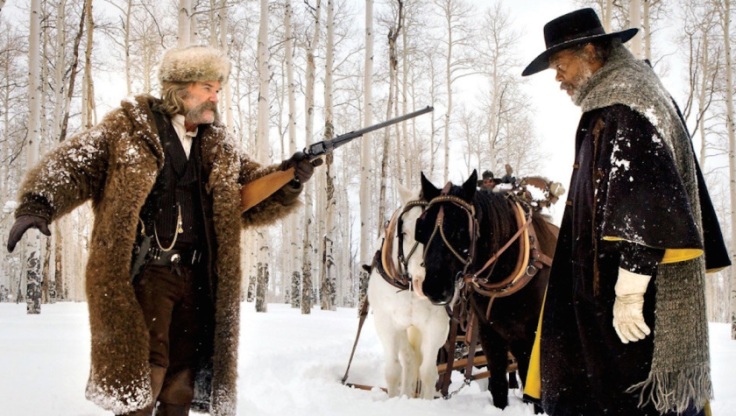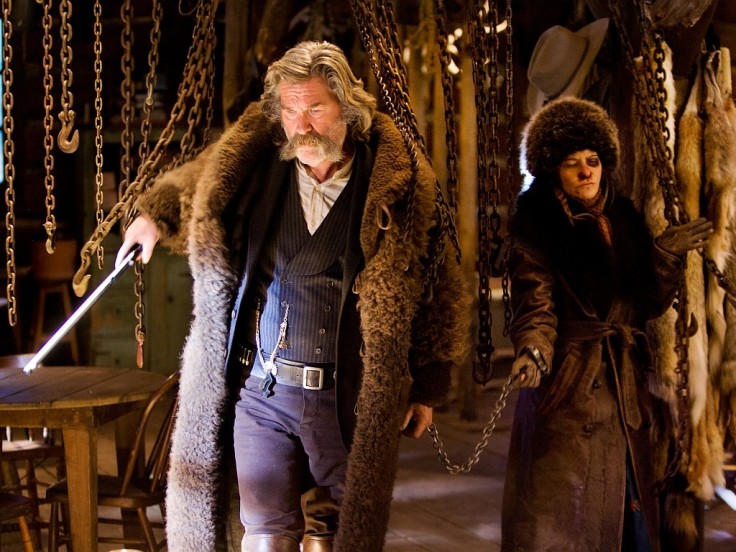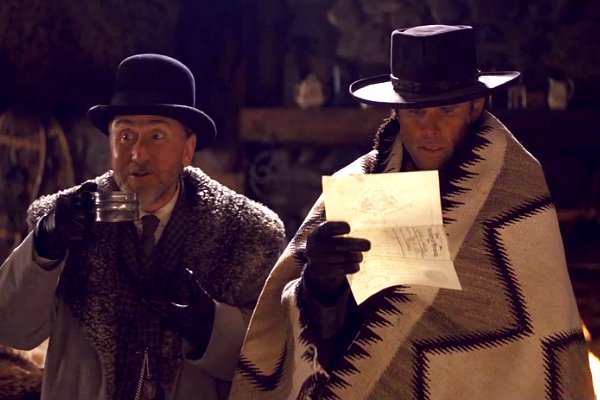By: Samar Khan
After years of hype and riding high off the excellent Inglourious Basterds and fairly solid Django Unchained, Quentin Tarantino finally delivered us the highly anticipated 8th installment of the Tarantino-verse. The Hateful Eight (The H8ful Eight as trailers referred to it as) is his attempt to revert to the style of his utterly fantastic Reservoir Dogs, a film that holds a high place on the list of all-time great chamber dramas. Unfortunately for modern audiences, while his attempt to mimic the self-contained singular room style of Reservoir Dogs is fairly well executed, The Hateful Eight harbours numerous flaws that prevent it from reaching the legendary status that the majority of the visionary auteur’s filmography has attained.
In order to keep this review as spoiler-free as possible, I will provide a plot synopsis that explains the foundation of the film for those that have not seen any trailers. There are eight characters, all of whom are locked in a single room for the majority of the film and play some role in either rescuing or freeing a captive bandit leader. Add on Quentin Tarantino’s political ideas and racism issues with a rather diverse cast and top it off with a key Samuel L. Jackson role and that is the essence of what the film is about.
Speaking of Jackson, he headlines a stellar cast that includes the likes of the legendary Kurt Russell rocking the most amazing of moustaches, Jennifer Jason Leigh as the most psychotic bandit leader seen in a Western in some time, Walton Goggins as the hilarious Sheriff Chris Mannix, Bruce Dern as a grumpy war veteran, Michael Madsen as a bandito, and Tim Roth as a mysterious “coroner.” The character interactions and banter amongst the crew as well as the dialogue is the saving grace of the film, with the kinds of humour that one has come to associate with Tarantino’s films. The film explores in depth, via the use of dialogue and storyline, race relations at the time of film (in the aftermath of the US Civil War) and offers a metaphorical commentary on modern day relations as well; while the concept was executed fairly well and got Tarantino’s message across, there were multiple scenes where it felt as if he was just repeatedly hammering home his points and thus caused the tone of the film to deviate from humour to a tone befitting political agendas.

It wasn’t all bad, however, regarding the characters as they were all expertly played. Jackson was a delight as is the norm when he is cast in a Tarantino film (which is essentially all of his films, isn’t it?), with one particular monologue late in the film delivered to Bruce Dern’s racist war veteran serving as the highlight of the film for both its hilarity and visual depiction. Walton Goggins steals the show as he has a tendency to do (just ask fans of TV’s Justified how stellar he can be), with his Sheriff routinely drawing the biggest laughs from the audience and providing the majority of the moments of relief that punctuated Tarantino’s rambling on racial politics. Kurt Russell, the star of almost every awesome action film not named Stallone or Schwarzenegger, is sublime as bounty hunter John Ruth yet also arguably underutilized; being cast as a character with a profession as action-oriented as a bounty hunter in a Tarantino film raises expectations of epic action scenes but they never come to materialize as Tarantino shifts the focus elsewhere.
Underutilized and yet also out-of-place amongst the rest of the cast is the character of Channing Tatum, whose role shall remain a surprise for those interested in seeing the film. Suffice it to say, his arc begins rather abruptly, ends jarringly and kicks off the portion of the film that just does not flow with the remainder of the film. To clarify the point made about the flow of the film, it was divided into multiple chapters so as to illustrate what events would be forthcoming; while the first few acts were chronological, Tatum’s appearance threw the flow out of the way and felt unnecessary to the rest of the film. Indeed, it felt as if Tarantino could have cut that one chapter entirely and still managed to deliver essentially the same story in a considerably shorter amount of time. While it’s not quite at the level of George Lucas in the Star Wars prequels, Tarantino could have used a more forceful editor, one that knew when to say “cut” and one that knew whether to cut scenes out of the film entirely.

Tarantino’s decision to extend the length of his film to three hours and add an overture sounded swell but was a poor decision in hindsight. The film’s most glaring flaw is the runtime itself, with the excellent dialogue and character interactions unable to make up for the lack of action that plagues the first three-quarters of it. In fact, without delving into spoiler territory, it becomes downright comical just how gratuitous the action and bloodshed became in that final quarter of the film, feeling as Tarantino decided he needed to fill his quota of massive amounts of gore and delivered it all at once. As one can infer from the title, there are eight characters in the film. The majority of these characters have their fates decided one way or another in that final quarter with barely a moment to reflect in between, with the gratuitous bloodshed taking clear precedence over allowing the audience to fully reflect upon what they had just experienced.
Robert Richardson’s cinematography is excellent throughout, another aspect that has been consistent throughout Tarantino’s prior films. While the majority of the film is set indoors, the framing of bloody shots and conversations between the characters complement the glorious snow scenes captured outside the room in question. Ennio Morricone was in charge of the soundtrack and while it was typical Tarantino fare, it lacked that special quality that defined specific segments in his prior films. For example, the introduction of the “Bear Jew” in Inglourious Basterds was accompanied by a rousing score; in The Hateful Eight, there are no memorable scenes where the score even has a chance to shine.

The true shame lies in that final sentence in the previous paragraph, that concerning the lack of memorable scenes. While the dialogue is indeed witty and some of the character interactions are indeed fun, there are far too many scenes that induced a sense of boredom. In a relatively packed theatre on opening night, it wasn’t uncommon to hear groans and/or sighs during certain scenes, showcasing the audience’s frustration with the simplistic story and the utter lack of any narrative coherence. Excellent visuals generally require at least adequate storytelling and, as mentioned, that is where the film falls flat and where Tarantino tries to make up for it by the aforementioned abundance of bloodshed in the final act.
If Pulp Fiction is Quentin Tarantino’s best film, Deathproof is his worst and that in itself was not an objectively terrible film. It’s rather telling when one can state that his newest venture, The Hateful Eight, exceeds only the latter in terms of quality. That essentially means that the film is fairly solid but could certainly improve in many facets, especially when it is compared to the other works put out by the director. Go into it with lowered expectations and a serviceable film you shall receive.
After careful consideration, we here at The Film Lawyers have decided to grade The Hateful Eight with a C+ (6.8/10).

Leave a comment